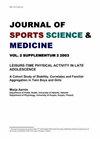在不稳定的表面上进行仰卧桥训练时,腹部收腹对膝关节屈曲角度对肌肉活动和肌肉厚度的影响。
IF 2.4
2区 医学
Q2 SPORT SCIENCES
引用次数: 0
摘要
本研究评估了在桥式训练和腹部收缩运动中躯干深肌厚度和下肢肌肉活动的变化。在不稳定的表面上,以不同的膝关节屈曲角度(60º、90º和120º)进行过桥练习,以确定更有效的过桥练习角度。本研究包括21名年龄在20-27岁的健康成年人。采用表面肌电图测量股二头肌(BF)、腹直肌和股直肌活动。测量腹横肌(TrA)、腹外斜肌(EO)和腹内斜肌(IO)的厚度。随着膝关节屈曲角度的减小,BF (p = 0.000,偏η2 = 0.670)活性显著增加。随着膝关节屈曲角度的减小,TrA (p = 0.000,偏η2 = 0.883)和IO (p = 0.000,偏η2 = 0.892)厚度显著增加,EO (p = 0.000,偏η2 = 0.893)厚度显著降低。在不稳定的地面上进行桥式训练时,膝关节屈曲角度应分别为120º和60º,以增加躯干稳定性和下肢肌肉活动。本文章由计算机程序翻译,如有差异,请以英文原文为准。
Comparison of Muscle Activity and Muscle Thickness According to Knee Flexion Angle during Supine Bridge Exercises using the Abdominal Drawing-in Maneuver on an Unstable Surface.
This study evaluated changes in deep trunk muscle thickness and lower extremity muscle activities during bridge exercises with the abdominal drawing-in maneuver. Bridge exercises were conducted on an unstable surface at different knee flexion angles (60º, 90º and 120º), with the aim of identifying more effective angles for bridge exercises. This study included 21 healthy adults, aged 20-27 years. Biceps femoris (BF), rectus abdominis, and rectus femoris activity was measured using surface electromyography. The thicknesses of the transverse abdominis (TrA), external oblique (EO) and internal oblique (IO) muscles were measured. BF (p = 0.000, partial η2 = 0.670) activity increased considerably as the knee flexion angle decreased. TrA (p = 0.000, partial η2 = 0.883) and IO (p = 0.000, partial η2 = 0.892) thickness significantly increased, while EO (p = 0.000, partial η2 = 0.893) thickness decreased as the knee flexion angle decreased. When performing bridge exercises using the abdominal drawing-in maneuver on an unstable surface, the knee flexion angles should be at 120º and 60º to increase trunk stability and lower extremity muscle activity, respectively.
求助全文
通过发布文献求助,成功后即可免费获取论文全文。
去求助
来源期刊
CiteScore
5.60
自引率
6.20%
发文量
56
审稿时长
4-8 weeks
期刊介绍:
The Journal of Sports Science and Medicine (JSSM) is a non-profit making scientific electronic journal, publishing research and review articles, together with case studies, in the fields of sports medicine and the exercise sciences. JSSM is published quarterly in March, June, September and December. JSSM also publishes editorials, a "letter to the editor" section, abstracts from international and national congresses, panel meetings, conferences and symposia, and can function as an open discussion forum on significant issues of current interest.

 求助内容:
求助内容: 应助结果提醒方式:
应助结果提醒方式:


